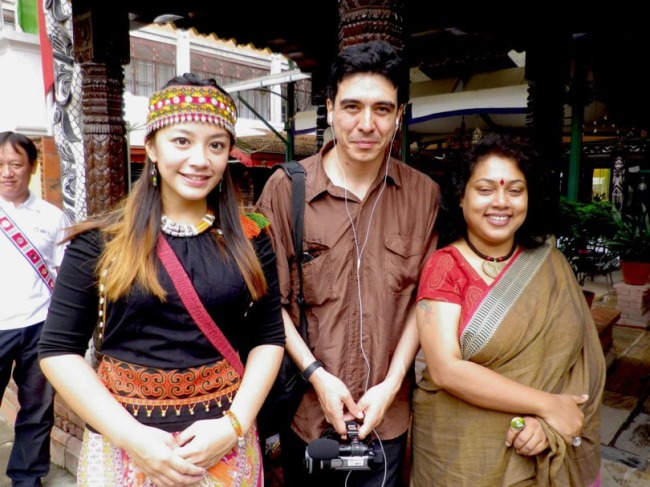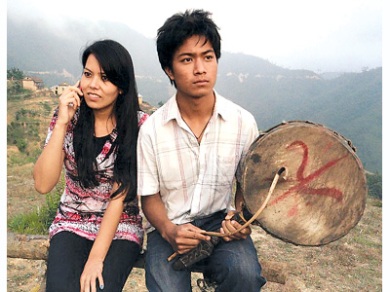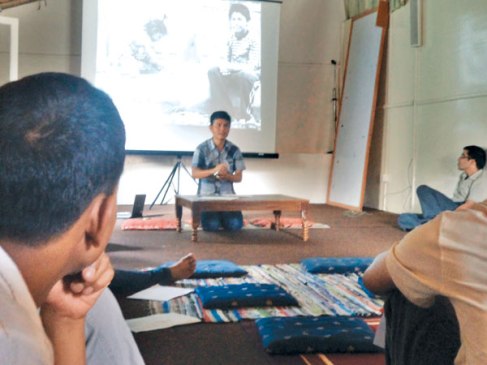 American Documentary filmmaker Carlos Gomez with Indian filmmaker Rwita Dutta and Taiwanese artist during The Nepal International Indigenous Film Festival-2012, Kathmandu.
American Documentary filmmaker Carlos Gomez with Indian filmmaker Rwita Dutta and Taiwanese artist during The Nepal International Indigenous Film Festival-2012, Kathmandu.
Published on Kantipur National Daily. visit: http://www.ekantipur.com/kantipur/news/news-detail.php?news_id=296908
- By Phulman Bal
Kathmandu: Carrying a pie chart of Colombia, last year an American filmmaker Carlos Gomez arrived to Nepal International Aboriginal Film Festival (NIF) and said to Nepali film makers: “I want to collaborate.” Clinging to that very determination, he arrived this time once again. This time he had a documentary movie based on Nepal. During the seventh convention of NIIFF, he displayed a documentary entitled as ‘Indigenous Media Postcard from Nepal’ as a spectator depicting the effort of Nepali aboriginal communities to preserve their culture and lifestyle; now he had a responsibility of jury member to cooperate on. Lost in far nooks of Nepal for three weeks after the mark of formal conclusion of the festival, he was convened at Basantapur of the capital as the twilight broke at a particular dusk.
“This time I got lost in the villages,” He, who was starting filmmaking of different nation and their communities said, “My days are all memorable which I spent on nearly extinct Nepali culture and diverse traditions.” As the festival halted he lunged to Panchthar to examine the uniqueness of Limbu culture; remained there for two weeks. He was assisted by Limbu festival organization, and even did a four days workshop on the film. There he prepared a documentary on Limbu myth on fire: ‘Misek’. The myth opines that the spark reaching a particular direction while torching the woods is an indicator for a new happening; he even edited this belief in his work.
“All the aborigines of the world seem same”, he told his emotions while wandering through the Limbu village carrying Panasonic GH6 camera, an Apple Computer, and a mini sound set, “From food to traditions to dance, all feels the same.” He added. With this nostalgia he even recalled his tour to Ecuador. When he reached Ecuador by sailing across the Amazon River continuously for two days in a small yacht with his Japanese wife, he was welcomed there by half naked aborigines of Ecuador. “See these people,” he said indicating the photo he uploaded in Facebook and added, “If we don’t make a film on their social status, it is soon going to be extinct.”
To the very community he donated a computer, a solar system, a camera, and a sound system to establish a media center, and he wants to exercise the same stuff in Nepal. Last year he donated a camera to Chandra Mangmu, resident of Paachthar; this year he has come up with greater ideas. After he returned from the east, he moved towards Kavre to find a new community with young film makers Prinaraj Joshi and Ravi Sharma where he made a new documentary movie on the role of community radios to preserve the cultural paradigm and the language of aborigines of that place.
“There we found a fascinating subject,” he said after collecting all the works of community radios and electing Radio Namobuddha as an ideal one, “Radios are connecting to various people across the globe.” During the shoot of documentary, he met Gunjaman Dong of Kavre, Tilam Machhegaun, whose progenies are living in America and he is working on the radio exalting the significance of culture and tradition wishing the future generation shall never marginalize these fundamental aspects. Dwelling in America for two decades, the sons of Gunjaman and their life is going to be featured in next documentary, Carlos said.
“This is community based documentary,” he even added the movement of his organization Cineminga, “I am planning to make this association worldwide, which actually started in 2007.” The president of Cineminga, a Colombian word for ‘cooperation in movies’, Carlos opined that during the era of globalization films are going to connect the communities of the world.” He has been conducting charity after he features the documentary visiting different parts of the globe. “I do have a plan to establish community film centers,” Carlos said as he is going to America this Monday, “Next year; I shall establish two such centers in Nepal.”


